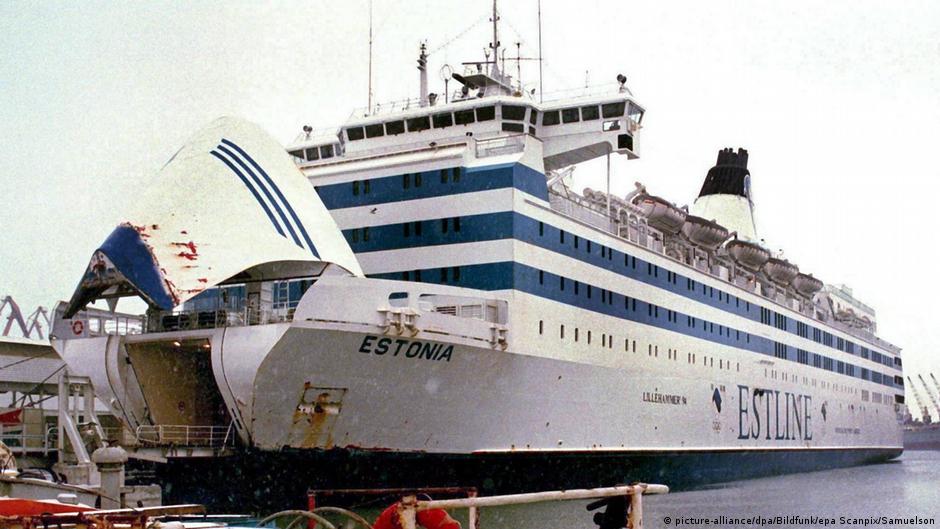The MS Estonia sank on September 28, 1994, between 00:50 and 01:50 UCT+2. The ship was crossing the Baltic Sea at the moment, en route from Tallinn, Estonia, to Stockholm, Sweden.
The ship departed on September 27 from Tallinn, and was expected in Stockholm the next morning at about 09:00.
Carrying 989 people, the ship remains a conspiracy subject many years after. Most of the passengers were Swedish, and some were of Estonian origin. Crew members, on the other hand, were Estonian.
Sinking of the Ship
According to the final disaster report, the weather was rough. There was wind of 15 to 20 m/s, force 7-8 on the Beaufort scale, and a significant wave height of 4 to 6m (13 to 20ft).
Esa Makela, captain of Silja Europa, appointed on-scene commander for the rescue effort, described the weather as “normally bad”. In other words, a typical autumn storm in the Baltic Sea.
![]()
The first sign of trouble came when a metallic bang was heard. Some presumed it was caused by a heavy wave hitting the bow doors around 01:00, when the ship was on the outskirts of the Turku archipelago. Yet, the inspection, showed no problems.
Over the next 10 minutes, similar noises were reported by passengers and crew. At 01:15, the visor is believed to have separated and torn open the loading ramp behind it.
At about 01:20, a quiet female voice called “alarm, alarm, there is alarm on the ship” in Estonian over the public address system. It was followed by an internal alarm for the crew, and one minute later by the general emergency signal.
Speaking about the passengers, most of them were Swedish. Casualties showed 501 deaths, and 51 survivors of Swedish origin. Estonia was second on the list, with 285 deaths and 62 survivors.
Latvia with 23 deaths and 6 survivors, Russia with 11 deaths and 4 survivors, and Finland with 10 deaths and 3 survivors round up the top 5 countries.
Other nationalities include people from Norway, Germany, Denmark, Lithuania, Morocco, the Netherlands, Ukraine, the United Kingdom, Belarus, Canada, France, and Nigeria.
The Official Report
The wreck was examined by underwater vehicles and by divers from a Norwegian company, contracted for the investigation work.
According to the official report, the locks on the bow door had failed from the strain of the waves and the door had separated from the rest of the vessel. This resulting in pulling the ramp behind it ajar.
Because the bow visor and ramp had been torn off, they triggered an open or unlatched warning on the bridge, as is the normal operation or failure of the latches.
![]()
The report said the bridge was also situated too far back on the ferry for the visor to be seen from there.
The report was mostly critical of the crew’s actions, especially their failure to reduce speed before investigating the noises emanating from the bow. The report also noted the crew was unaware that the list was being caused by water entering the vehicle deck.
Criticism of the delays in sounding the alarm, passivity of the crew, and lack of guidance from the bridge was also noted.
Following the accident, recommendations for modifications to be applied in similar ships followed. They included separation of the condition sensors from the latch and hinge mechanisms.
Conspiracy Theories
While the official report criticized the crew, over the years, the ship and sinking of it have been a subject of conspiracy theories.
More than 25 years have passed since the tragedy. Yet, there are more and more conspiracy theories.
The most prominent theory is that MS Estonia was sabotaged. It was proposed by journalist and writer Knut Carqvist in 2001. He claimed that vehicles loaded with military equipment were on board, leading to assume that weaponry was covertly smuggled via Estonia to Sweden and beyond.
![]()
In 2006 book on conspiracy theories, political scientist Erik Asard proposed a different theory. He addressed the arguments in the case of MS Estonia. He found flaws in Carlqvist’s explanation, but Asard still thought there is some conspiracy regarding MS Estonia.
In 1998, shipbuilding engineer Anders Bjorkman, provided a different explanation. He claimed that the bow visor was removed deliberately after the disaster to conceal evidence. Anders believed the ferry was hit by something under the waterline, and claimed it was a political conspiracy.
In 1999, one of Bjorkman’s comrades in arms, went even further. He released a book, saying that the ferry might have been hit by a Russian torpedo from a submarine to thwart the export of sensitive military technology.
What MS Estonia changed?
Following the disaster, there were changes stemming from it. In 1999, special requirements in crowd and crisis management and human behavior were extended to crew on all passenger ships.
All EPIRBs were subsequently required to deploy automatically and the accident was instrumental in the move to legislate Voyage Data Recorders.
New designs of ships, the citadel concept, aimed to ensure damaged ships have sufficient buoyancy to remain afloat, though cost will determine if any will be built.
The 2020 Investigation
On September 28, 2020, a Swedish documentary was released. It used underwater equipment to film the wreck, and found a 4-metre hole in the ship’s hull.
This prompted the Estonian prime minister and foreign minister to meet with their Swedish and Finnish equivalents. They announced a new technical investigation would take place.
![]()
In October 2020, the Estonian government published a report stating that the hole was too small to have sunk the ship. Swedish documentary makes were being prosecuted for violating the sanctity of the wreck. But they were acquitted on February 8, 2021 as the diving happened on a German ship in international waters. And Germany had not signed the treaty declaring sanctity over the site.



